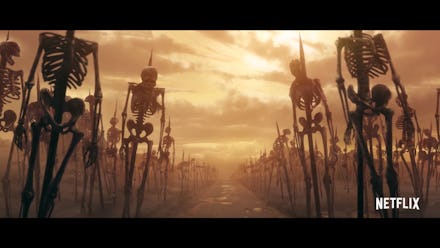‘Castlevania’ Netflix Review: A shockingly decent video game adaptation

Just about every movie or TV adaptation of a video game I’ve ever seen has been gutter trash for one reason or another. My impulse is to always expect nothing, and I usually get less than that in return. So when Netflix announced it would host an anime based on Castlevania, I shoved it into that dismissive corner of my brain and wasn’t sure I’d even watch it.
After realizing the entire first season is just four 25-minute episodes, I figured it was probably worth my time to give it a shot — and, thankfully, I was right. I’m glad to say Castlevania is more than worth the evening it takes to finish it.
Netflix made a totally alright Castlevania anime
Castlevania comes courtesy of young maverick producer Adi Shankar and prominent, prolific comics and film writer Warren Ellis. The first season, released Friday, is a four-episode arc that basically sets up the plot of Castlevania III: Dracula’s Curse and ends right as things are about to get cool. Thankfully, we’re getting a second season.
As the corrupt Christian church tightens its grip on Wallachia — now part of Romania — in the 1400s, a particular bishop really screws up by declaring Dracula’s wife a witch and burning her at the stake. The count, being about as diplomatic as he can be in his position, gives the people of Wallachia a year to get out before the armies of hell wipe out whatever is left in the region.
Of course, nobody listens and it’s up to Trevor Belmont, last of the legendary and shunned monster hunting clan, to take down Dracula before there’s nothing left to save. True to the game upon which the series is based, he’s eventually joined by the sorceress Sypha and Alucard, the son of Dracula.
Castlevania III is a game about deliberately trudging from left to right, navigating hellish platforming sequences and killing punishing bosses. Originally released on NES, it was light on explicit narrative outside of a couple text scrolls and whatever was in the manual. That means the creative team had plenty of room to get imaginative.
For the most part, I think the end result is admirable. In an interview with Mic, Shankar pointed to the generational gap between creators and consumers as one of the problems with video game adaptations. I think there’s something to that, but mere fandom and understanding of source material isn’t enough to generate a compelling adaptation. You also have to know what does and doesn’t work in a fundamentally different format.
The silent, stoic Trevor from Castlevania III has been replaced by a haggard, vulgar drunk who, like him or not, knows what to do in the case of a monster invasion. Dracula disappears after the first episode, but he’s presented as a character with an actual motive and pathos rather than an omnipotent villain. Really, for most of the series, the cartoonishly evil Christians are more threatening than any vampires or ghouls.
Castlevania takes the M-rated video game approach to adult content, in that there’s a whole lot of cussing and blood. Some of that worked for me and some of it didn’t. I actually found the gore to be surprisingly effective, with one sequence actually making me shout. The dialogue can range from funny to grating, with a particular line about Trevor’s testicles demonstrating the latter end of the spectrum.
Castlevania’s best quality is that it nails the correct amount of fan service. It was probably tempting to make four episodes of Trevor Belmont whipping demon ass with little winks and nods to things from the games, set to modern arrangements of classic Castlevania music. Instead, this Netflix series is its own thing while being recognizable as Castlevania.
That’s not to say there isn’t any fan service, mind you. At one point, Trevor throws holy water on the ground to burn up some demons before perilously jumping around on giant, spinning gears. The climactic fight between Trevor and Alucard in the finale is also pretty fun if you’re into Castlevania at all.
Another quality that makes this series appealing to me, personally, is that it goes back to basics with Castlevania. That series went in so many weird directions that it eventually became somewhat unrecognizable to people like me who enjoy the purity of classic Castlevania. I want someone named Belmont (Trevor, Simon, Richter, I don’t care) to use a whip to fight Dracula. Instead, the more recent Lords of Shadow reimagined Dracula as a Belmont himself who gets in a Dragon Ball Z-style fight against Satan, which is just one example of how weird Castlevania eventually got.
Shankar and Ellis walked it back here. This isn’t Castlevania: [Musical Term] of [Thing]. It’s just Castlevania. I like that a lot.
I’m not going to act like Castlevania is the best thing you could watch on Netflix right now. It’s enjoyable popcorn entertainment for an evening and not much more. Unfortunately, that’s the very best you can expect from something based on a video game. The fact I’m interested in watching a second season is just about the best endorsement imaginable.
More gaming news and updates
Check out the latest from Mic, like this essay about the sinister, subtle evils lurking in rural America that Far Cry 5 shouldn’t ignore. Also, be sure to read our review of Tekken 7, an article about D.Va’s influence on one Overwatch player’s ideas about femininity and an analysis of gaming’s racist habit of darkening villains’ skin tones.